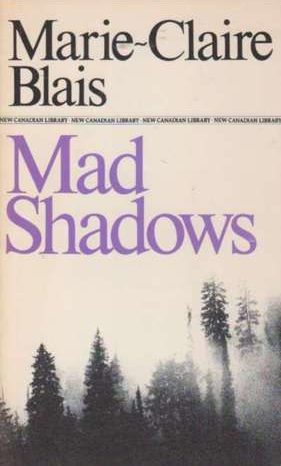 By MARIE-CLAIRE BLAIS (McClelland and Stewart; 1960/71)
By MARIE-CLAIRE BLAIS (McClelland and Stewart; 1960/71)
A much-lauded novel, the first by the prolific French-Canadian novelist Marie-Claire Blais (of A TWILIGHT CELEBRATION, NOTHING FOR YOU HERE, YOUNG MAN and THESE FESTIVE NIGHTS), that offers a potent reminder that a great deal of renowned Canadian fiction tends toward the macabre. Examples include KAMOURASKA, BEAR and THE LAST OF THE CRAZY PEOPLE, in whose antisocial company the bleak and bloody yet unabashedly literary MAD SHADOWS fits quite snugly.
…a potent reminder that a great deal of renowned Canadian fiction tends toward the macabre.
It was initially published in 1960, when its author was just 20. The writing is strong (and ably translated by Merloyd Lawrence), finding a comfortable middle ground between the poetic and the pulpy. That, however, does not excuse the author’s conceptual immaturity, which is evident in the very broad, surface-level characterizations.
The writing is strong (and ably translated by Merloyd Lawrence), finding a comfortable middle ground between the poetic and the pulpy.
A warped family drama, the novel introduces us to Patrice, a young simpleton who gets by because, simply, he’s extremely good-looking. He’s doted on by his mother Louise, who views him as an idealized extension of herself, while his sister Isabelle-Marie, who’s extremely ugly, is consumed by jealousy, as evidenced by the acts of petty torture to which she subjects her brother. Into this hothouse come two outsiders: the crippled Lanz, who romances Louise, and the blind Michael, who takes up with, and impregnates, Isabelle-Marie. Their intercession only serves to inflame an already overheated dynamic that ends in disillusion, disfigurement and murder.
These characters’ actions are accompanied, more often than not, by minute psycho-poetic probing (“All the sweetness which Lanz had taken away from him was now lavished again on Patrice. With it, the child rediscovered his love for himself, his confidence in the perfect harmony of his own body”). This doesn’t change the fact that these people are all painfully reductive and simplistic, defined in all cases by their major physical attributes—with Patrice’s entire identity bound up in his good looks, Isabelle-Marie’s in her ugliness, Michael in his blindness, etc.—and, in a narrative that spans two decades, apparently incapable of charge. It’s here that the author’s youthfulness is most evident; a gifted writer Marie-Claire Blais undoubtedly is, but in 1960 she clearly had a ways to go before attaining her full potential.
